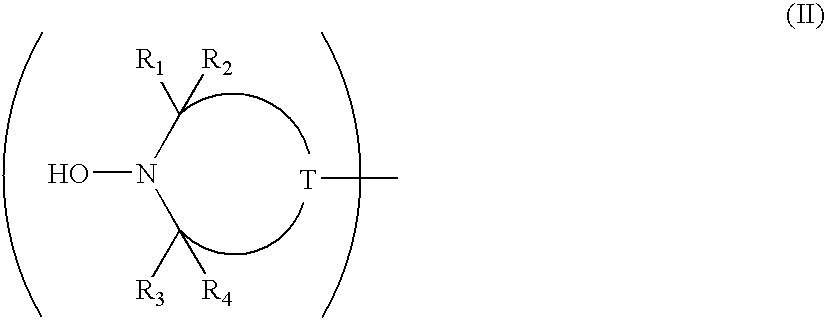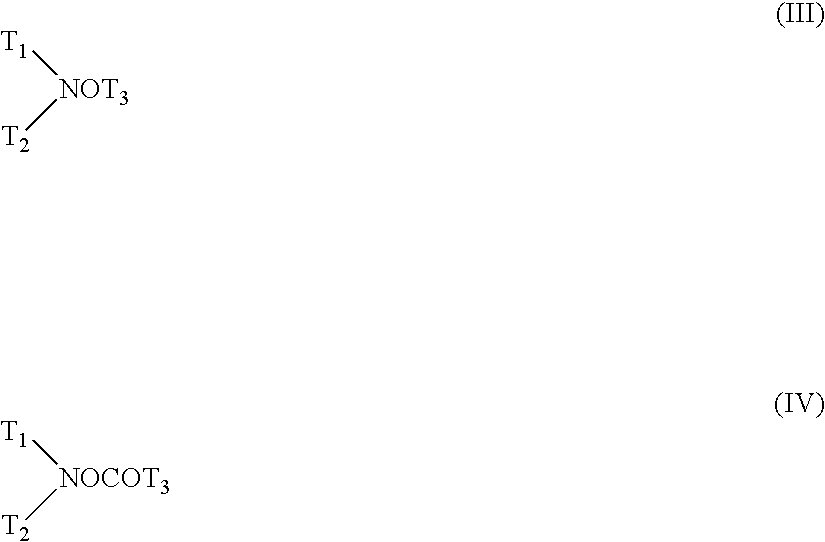Polyester and polyamide compositions of low residual aldehyde content
a polyamide and polyamide technology, applied in the direction of rigid containers, packaging, synthetic resin layered products, etc., can solve the problems of reducing mechanical properties, undesirable taste or flavor of acetaldehyde in bottled water, and undesirable yellowing
- Summary
- Abstract
- Description
- Claims
- Application Information
AI Technical Summary
Benefits of technology
Problems solved by technology
Method used
Image
Examples
example 1
[0241]Unstabilized commercial PET (CLEARTUF 7207, Shell) is used as a control PET. When PET is extrusion compounded, a significant reduction in the amount of acetaldehyde (AA) is observed in samples stabilized with additives of the present invention compared to unstabilized PET. The % AA reduction is the amount less compared to the amount of AA in the control, all measured by GC-FID. Results are in the table below. Additive levels are in parts per million (ppm) based on PET.
[0242]
GCFIDAdditive% AAavg. ppmFormulationAdditiveLevel (ppm)ReductionAAControl—none—3.2Anitrone1500 47*1.7Bnitrone5000561.4Cnitrone15000441.8Dhydroxylamine-A1500531.5Ehydroxylamine-A5000691.0Fhydroxylamine-A15000621.2“Hydroxylamine-A” is N,N-di(hydrogenated tallow)hydroxylamine as prepared in Example 9 of U.S. Pat. No. 4,876,300.“Nitrone” is the corresponding nitrone, that is primarily N-octadecyl-α-heptadecylnitrone.
[0243]It is seen that the additives of the present invention provide significant reduction of ac...
example 2
[0244]Unstabilized commercial PET (CLEARTUF 7207, Shell, Certificate of Analysis of 1.4 ppm AA as received) is used as a control PET. Upon a single extrusion heat history, the unstabilized PET increases in acetaldehyde (AA) content to an avg. of 3.0 ppm, indicating that PET produces undesirable AA upon heated melt processing. When PET is extrusion compounded, a significant reduction in the amount of acetaldehyde (AA) is observed in samples stabilized with additives of the present invention compared to unstabilized PET. The % AA reduction is the amount less compared to the amount of AA in the control, all measured by GC-FID. Results are in the table below. Additive levels are in parts per million (ppm) based on PET.
[0245]
GCFIDAdditive% AAavg. ppmFormulationAdditiveLevel (ppm)ReductionAAControl—none—3.0Gnitrone500242.3Hnitrone1500511.5Initrone5000571.3Jhydroxylamine-A500292.1Khydroxylamine-A1500351.9Lhydroxylamine-A5000641.1MDBHA500122.6NDBHA1500302.1ODBHA5000381.9“Hydroxylamine-A” is...
example 3
[0247]Unstabilized commercial PET (CLEARTUF 8006, Shell) is used as a control PET. When PET is extrusion compounded, a significant reduction in the amount of acetaldehyde (AA) is observed in samples stabilized with additives of the present invention compared to unstabilized PET. The % AA reduction is the amount less compared to the amount of AA in the control, all measured by GC-FID. Results are in the table below. Additive levels are in parts per million (ppm) based on PET.
[0248]
GCFIDAdditive% AAavg. ppmFormulationAdditiveLevel (ppm)ReductionAAControl—none—4.2Phydroxylamine-A500303.0Qhydroxylamine-A2500631.6Rhydroxylamine-B500213.3Shydroxylamine-B2500631.6Tamine oxide500322.9Uamine oxide2500522.0“Hydroxylamine-A” is N,N-di(hydrogenated tallow)hydroxylamine as prepared in Example 9 of U.S. Pat. No. 4,876,300.“Hydroxylamine-B” is a commercial sample of N,N-di(hydrogenated tallow)hydroxylamine, Irgastab ® FS-042, Ciba Specialty Chemicals Corp., CAS# 143925-92-2.“Amine oxide” is Genox ...
PUM
| Property | Measurement | Unit |
|---|---|---|
| temps | aaaaa | aaaaa |
| melt temperature | aaaaa | aaaaa |
| retention time | aaaaa | aaaaa |
Abstract
Description
Claims
Application Information
 Login to View More
Login to View More - R&D
- Intellectual Property
- Life Sciences
- Materials
- Tech Scout
- Unparalleled Data Quality
- Higher Quality Content
- 60% Fewer Hallucinations
Browse by: Latest US Patents, China's latest patents, Technical Efficacy Thesaurus, Application Domain, Technology Topic, Popular Technical Reports.
© 2025 PatSnap. All rights reserved.Legal|Privacy policy|Modern Slavery Act Transparency Statement|Sitemap|About US| Contact US: help@patsnap.com



